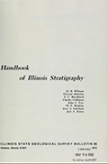Historical:Fern Glen Formation
Lithostratigraphy: Mammoth Cave Limestone Megagroup >>Fern Glen Formation
Chronostratigraphy: Paleozoic Erathem >>Mississippian Subsystem >>Valmeyeran Series
Allostratigraphy: Kaskaskia Sequence
Authors
Elwood Atherton, Charles Collinson, and Jerry A. Lineback
Name Origin
The Fern Glen Formation (S. Weller, 1906b, p. 438) is named for Fern Glen Station on the Missouri Pacific Railroad, 20 miles west of St. Louis.
Type Section
The type section of the Fern Glen Formation is in the Missouri River bluffs near St. Louis, Missouri where it consists of 30-40 feet of red and green calcareous shale, shaly limestone, and a basal bed of massive, yellowish gray, magnesian limestone.
Extent and Thickness
The Fern Glen occurs in western Illinois from Randolph County north to Jersey County and in a belt extending northeast to southwestern Champaign County. It is typically exposed in the Chautauqua West Section, southern Jersey County (SW NE 13, 6N-12W), where it includes about 20 feet of calcareous shale, crinoidal limestone, and greenish gray chert (Collinson, 1969). It is also well exposed near Valmeyer, Monroe County (SE SE 3, 3S-11W). Throughout most of its extent, the Fern Glen is less than 50 feet thick, but in a few small areas in St. Clair, Sangamon, and Christian Counties, it approaches 100 feet.
Stratigraphic Position
The Fern Glen overlaps the underlying Meppen Limestone to rest on truncated older rocks, as old as the Maquoketa Shale Group. It grades vertically and laterally into the overlying Burlington Limestone, and the boundary is ordinarily drawn at the top of the youngest red or green bed.
Description
The formation consists of green and red calcareous shale and of gray, green, and red limestone and dolomite that is partly argillaceous. The lower part is generally shaly and noncherty, while the upper part is mainly limestone containing small nodules of greenish gray chert.
Fossils
Fossils are abundant in the Fern Glen, notably brachiopods, corals, and crinoids. The more common fossils include the brachiopods Spirifer vernonensis, S. rowleyi, Athyris lamellosa, and Leptaena rhomboidalis, the bryozoan Evactinopora sexradiata, and the coral Cyathaxonia arcuata. The conodont Bactrognathus--Polygnathus communis Zone occurs in the Fern Glen Formation and the lower part of the Burlington Limestone.
References
COLLINSON, CHARLES, 1969, Devonian-Mississippian biostratigraphy of northeastern Missouri and western Illinois: North American Paleontological Convention Field Trip 3, 23 p.
WELLER, STUART, 1906b, Kinderhook faunal studies--4. Fauna of the Glen Park limestone: St. Louis Academy of Science Transactions, v. 16, p. 435-471.
ISGS Codes
| Stratigraphic Code | Geo Unit Designation |
|---|---|
